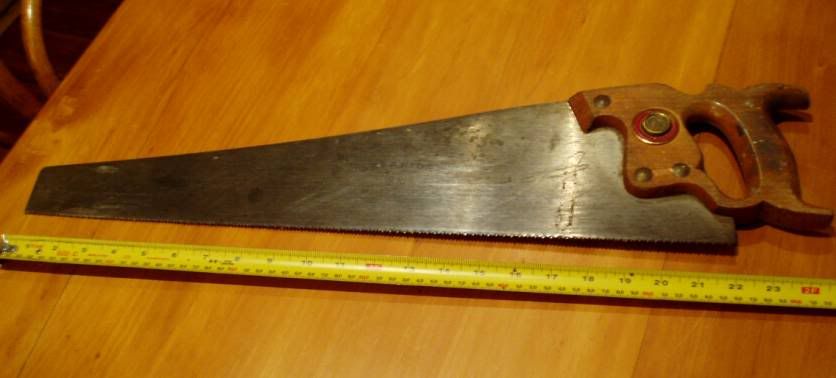MikeW
Established Member
I dimension wood with handsaws more than occasional.
The other night for a project I used them exclusively and it got me wondering how much/little others use handsaws. And if so, what lengths and PPIs (points per inch) do you find most useful?
This question was asked on another forum recently by someone else. When I answered I didn't really give it a lot of thought, but have been more conscious about usage since.
For myself, I have a few more than I need (some are getting sold in my quest for less), I find I tend to use the following.
Crosscutting--rough dimensioning
When I have serious work using saw horses, a 28" 5 ppi for thick planks and a 28" 7 ppi for 4/4 stock.
Ripping
Ripping using a handsaw is fast--sort of. It's all relative I suppose. As I shoot or joint edges following ripping, my gauge line is usually 1/8" wider than I want to end up on thick stock or about 1/6" on 4/4 or less. A few passes with a plane takes me to the line. I also joint one edge and gauge from it.
I use one of 3 saws. For thicker exotics, I use a 28" 4 1/2 or a 5 ppi, but sometimes it can be jarring at that ppi, so then it is a 7 ppi. For 4/4 and less stock I use a 28" 7 ppi. When held vertically in the bench vice for shorter lengths, I use a 24" 7 ppi.
I rip following rough dimensioning with a crosscut so there is less length to rip.
Crosscutting--final dimensioning
Done after the above and after initial jointing and flattening.
Most used is either a 26" 8 or a 26" 10 ppi. When done on my bench top, I use a 20" 9 ppi or else my miter saw if under 8". Small, thin stock I usually use a small Marples miter box and a backsaw.
So, does anyone else use handsaws for other than carpentry?
Mike
The other night for a project I used them exclusively and it got me wondering how much/little others use handsaws. And if so, what lengths and PPIs (points per inch) do you find most useful?
This question was asked on another forum recently by someone else. When I answered I didn't really give it a lot of thought, but have been more conscious about usage since.
For myself, I have a few more than I need (some are getting sold in my quest for less), I find I tend to use the following.
Crosscutting--rough dimensioning
When I have serious work using saw horses, a 28" 5 ppi for thick planks and a 28" 7 ppi for 4/4 stock.
Ripping
Ripping using a handsaw is fast--sort of. It's all relative I suppose. As I shoot or joint edges following ripping, my gauge line is usually 1/8" wider than I want to end up on thick stock or about 1/6" on 4/4 or less. A few passes with a plane takes me to the line. I also joint one edge and gauge from it.
I use one of 3 saws. For thicker exotics, I use a 28" 4 1/2 or a 5 ppi, but sometimes it can be jarring at that ppi, so then it is a 7 ppi. For 4/4 and less stock I use a 28" 7 ppi. When held vertically in the bench vice for shorter lengths, I use a 24" 7 ppi.
I rip following rough dimensioning with a crosscut so there is less length to rip.
Crosscutting--final dimensioning
Done after the above and after initial jointing and flattening.
Most used is either a 26" 8 or a 26" 10 ppi. When done on my bench top, I use a 20" 9 ppi or else my miter saw if under 8". Small, thin stock I usually use a small Marples miter box and a backsaw.
So, does anyone else use handsaws for other than carpentry?
Mike




































